SDG 16 – Peace, Justice and Strong Institutions
SDG 16 – Peace, Justice and Strong Institutions
Published on :- July 28th, 2022
Peace, Justice, and Strong Institutions is the 16th SDG. Owing to the significant challenges and stagnating growth seen in recent years, India ranked 119th in the world for SDG 16, with a score of 58.88 Death, Displacement, and Conflict
Numerous factors are considered when assessing the state of Peace and Justice that a nation provides its citizens, with death and displacement being some of them. Data from the National Crime Records Bureau(NCRB) shows the number of persons displaced across the country over the last decade. Internal displacement in India has been very erratic since 2010, with a sharp rise in 2012, 2014, and 2016, reaching 5 Cr people at its peak in 2012. Data also shows that these displacements have resulted from natural disasters and regional conflicts, among other issues.
Deaths due to conflict are a critical factor when assessing peace in a nation. Between 1990 and 2020, the number of deaths resulting from conflict increased sharply in 1992 and 2001 but has subsequently reduced consistently, falling to 587 at the end of the last decade.
A similar decreasing trend is visible in the rate of murders per 1 lakh of population, decreasing from 5,057 in 1990 to 2,200 in the late 2010s.
Death, Displacement, and Conflict
Numerous factors are considered when assessing the state of Peace and Justice that a nation provides its citizens, with death and displacement being some of them. Data from the National Crime Records Bureau(NCRB) shows the number of persons displaced across the country over the last decade. Internal displacement in India has been very erratic since 2010, with a sharp rise in 2012, 2014, and 2016, reaching 5 Cr people at its peak in 2012. Data also shows that these displacements have resulted from natural disasters and regional conflicts, among other issues.
Deaths due to conflict are a critical factor when assessing peace in a nation. Between 1990 and 2020, the number of deaths resulting from conflict increased sharply in 1992 and 2001 but has subsequently reduced consistently, falling to 587 at the end of the last decade.
A similar decreasing trend is visible in the rate of murders per 1 lakh of population, decreasing from 5,057 in 1990 to 2,200 in the late 2010s.
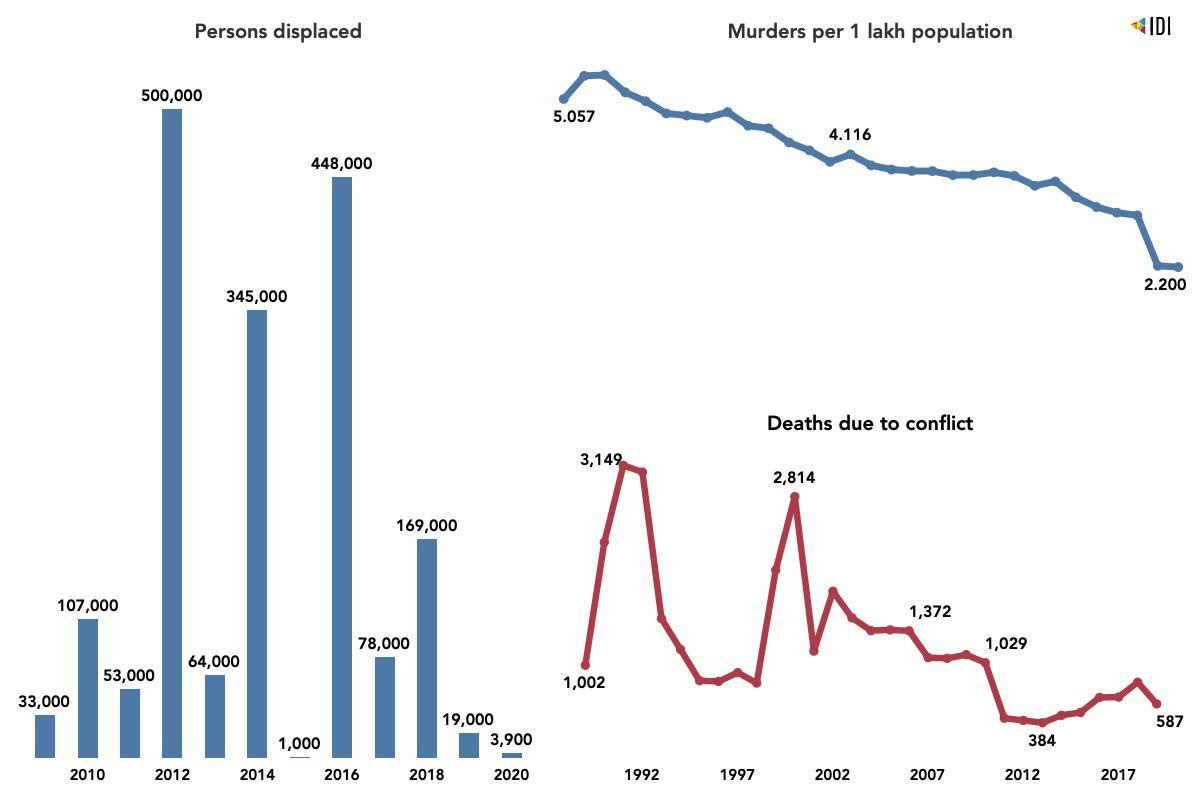 Another significant contributor affecting peace is Human Trafficking, with an average of 5 cases of human trafficking per lakh population. However, the rate of trafficking has drastic geographic variation across the country, with significantly high trafficking rates in the states of Goa, Odisha, Chhattisgarh, Mizoram, Manipur, and Delhi, all of which are 30% above the average.
Another significant contributor affecting peace is Human Trafficking, with an average of 5 cases of human trafficking per lakh population. However, the rate of trafficking has drastic geographic variation across the country, with significantly high trafficking rates in the states of Goa, Odisha, Chhattisgarh, Mizoram, Manipur, and Delhi, all of which are 30% above the average.
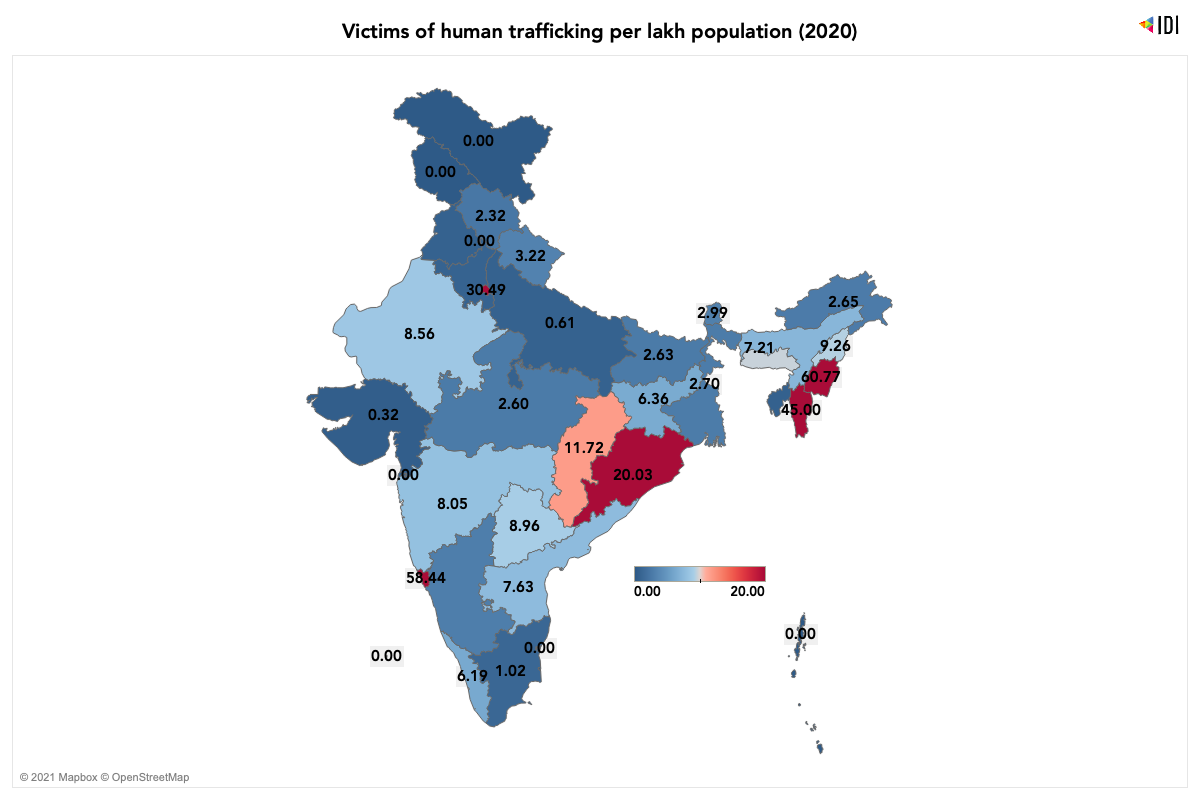 Alongside Human Trafficking, Crimes against Children is a significant contributing factor towards peace in a nation. This is made up of two key elements - Missing Children, i.e., A child who has disappeared and whose status as alive or dead can not be confirmed as their location/status is unknown, and cognizable crimes against children.
In the last three years, NCRB data shows that the number of children missing per 1 lakh of the population has risen by 143% from 2018 to 2020, reaching 1592 children per lakh population in 2020.
However, similar to Human Trafficking, the number of missing children varies significantly across states, with Delhi and Madhya Pradesh having the highest rate at 113.5 and 36.6 children per 1 lakh population; this trend is also seen when looking at the cognizable crimes against children per 1 lakh of population, which is highest in Haryana, followed by Sikkim, Madhya Pradesh, Chattisgarh, and Assam.
Alongside Human Trafficking, Crimes against Children is a significant contributing factor towards peace in a nation. This is made up of two key elements - Missing Children, i.e., A child who has disappeared and whose status as alive or dead can not be confirmed as their location/status is unknown, and cognizable crimes against children.
In the last three years, NCRB data shows that the number of children missing per 1 lakh of the population has risen by 143% from 2018 to 2020, reaching 1592 children per lakh population in 2020.
However, similar to Human Trafficking, the number of missing children varies significantly across states, with Delhi and Madhya Pradesh having the highest rate at 113.5 and 36.6 children per 1 lakh population; this trend is also seen when looking at the cognizable crimes against children per 1 lakh of population, which is highest in Haryana, followed by Sikkim, Madhya Pradesh, Chattisgarh, and Assam.
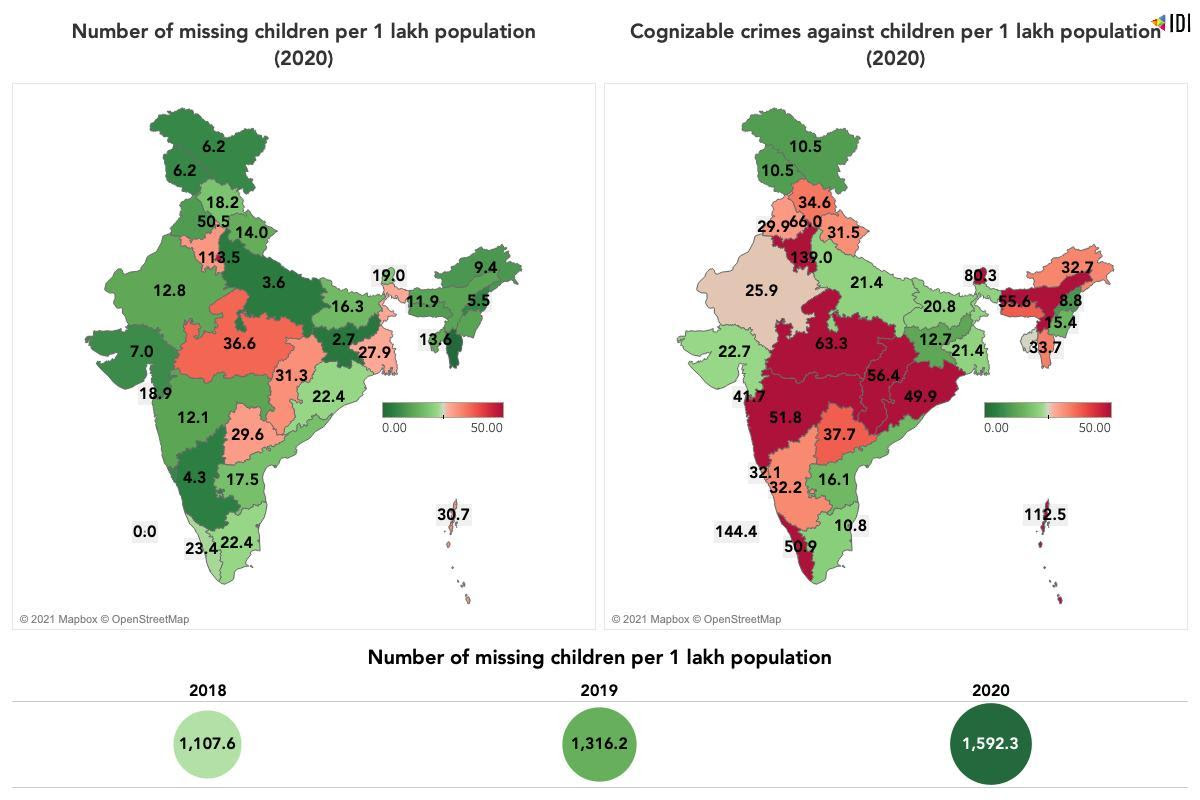 Pending Judicial Cases
A well-equipped and well-functioning Justice system helps improve the quality of life and overall peace in a nation. The National Judicial Data Grid shows the number of Pending cases (i.e., any cases that are yet to be presented to the court or pending trial/verdict/motion or jury selection) and the unsentenced detainees. The number of pending cases is classified based on the time it has been in the system.
In 2020, 4.35 crore pending cases existed in the country, of which 12.2 million have been filed in the last year and are still pending. This number decreases consistently, with 2.17 million cases pending for 10-20 years, 0.49 million cases pending over the previous 20-30 years, and 0.1 million cases pending in the system for over 30 years. Despite the year-on-year decrease, the rate is high overall.
In the case of unsentenced detainees, the percentage share has risen between 2015 and 2019. However, this number has consistently remained over 67%, reaching an all-time high of 69.4% of the total prison population in 2018.
Pending Judicial Cases
A well-equipped and well-functioning Justice system helps improve the quality of life and overall peace in a nation. The National Judicial Data Grid shows the number of Pending cases (i.e., any cases that are yet to be presented to the court or pending trial/verdict/motion or jury selection) and the unsentenced detainees. The number of pending cases is classified based on the time it has been in the system.
In 2020, 4.35 crore pending cases existed in the country, of which 12.2 million have been filed in the last year and are still pending. This number decreases consistently, with 2.17 million cases pending for 10-20 years, 0.49 million cases pending over the previous 20-30 years, and 0.1 million cases pending in the system for over 30 years. Despite the year-on-year decrease, the rate is high overall.
In the case of unsentenced detainees, the percentage share has risen between 2015 and 2019. However, this number has consistently remained over 67%, reaching an all-time high of 69.4% of the total prison population in 2018.
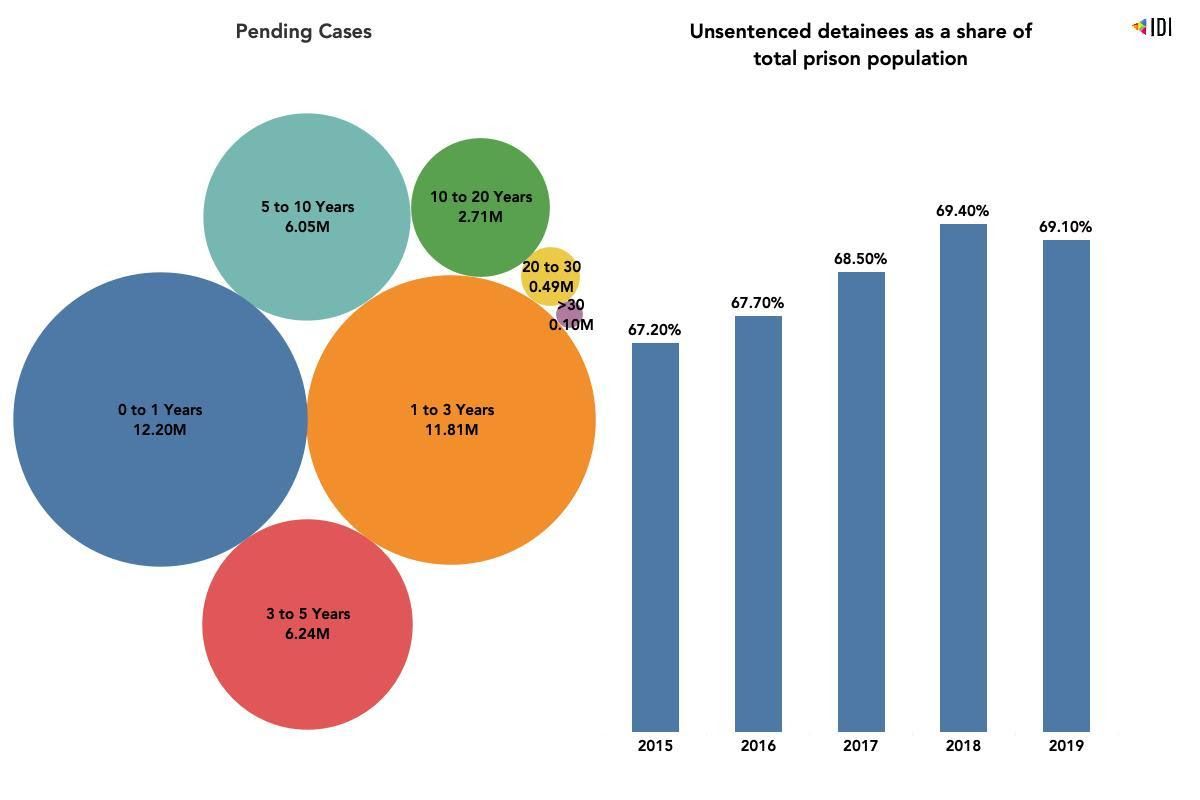 Birth Registry and Identification
The third and final component of the 16th SDG is Institutions. Strong institutions play a critical role in building a strong nation; birth registration, identification, and press are a few of the many contributing factors.
Births registered looks at the percentage of births registered at institutions against the estimated total number of births in the country.
Since 2009, the percentage of registered births has witnessed a steady increase over the last decade. This is a result of slowly increasing accessibility to better infrastructure for birthing. In addition, birth registration helps create legal proof of identity and can help protect children against violence, abuse, and exploitation, while also enabling them to attain routine vaccinations and healthcare services.
Birth Registry and Identification
The third and final component of the 16th SDG is Institutions. Strong institutions play a critical role in building a strong nation; birth registration, identification, and press are a few of the many contributing factors.
Births registered looks at the percentage of births registered at institutions against the estimated total number of births in the country.
Since 2009, the percentage of registered births has witnessed a steady increase over the last decade. This is a result of slowly increasing accessibility to better infrastructure for birthing. In addition, birth registration helps create legal proof of identity and can help protect children against violence, abuse, and exploitation, while also enabling them to attain routine vaccinations and healthcare services.
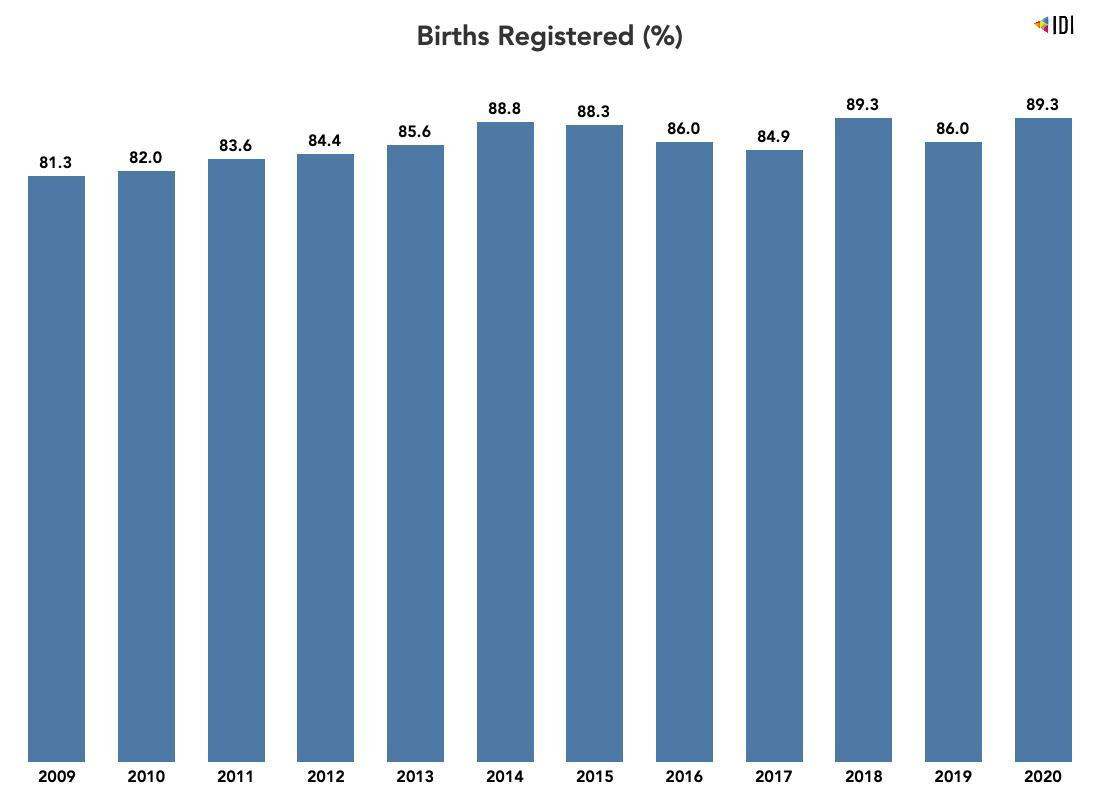 Along with birth registration, a consistent form of identification is also crucial. With the introduction of the Unique Identification Authority of India, 99% of the population in India now has unique identification in the form of an Aadhar card.
However, the percentage of the population covered under Aadhar varies significantly across the nations. The percentage of the population having Aadhar cards in North East India is extremely low, with less than 50% of the population in Assam and Meghalaya having Aadhaar cards.
Along with birth registration, a consistent form of identification is also crucial. With the introduction of the Unique Identification Authority of India, 99% of the population in India now has unique identification in the form of an Aadhar card.
However, the percentage of the population covered under Aadhar varies significantly across the nations. The percentage of the population having Aadhar cards in North East India is extremely low, with less than 50% of the population in Assam and Meghalaya having Aadhaar cards.
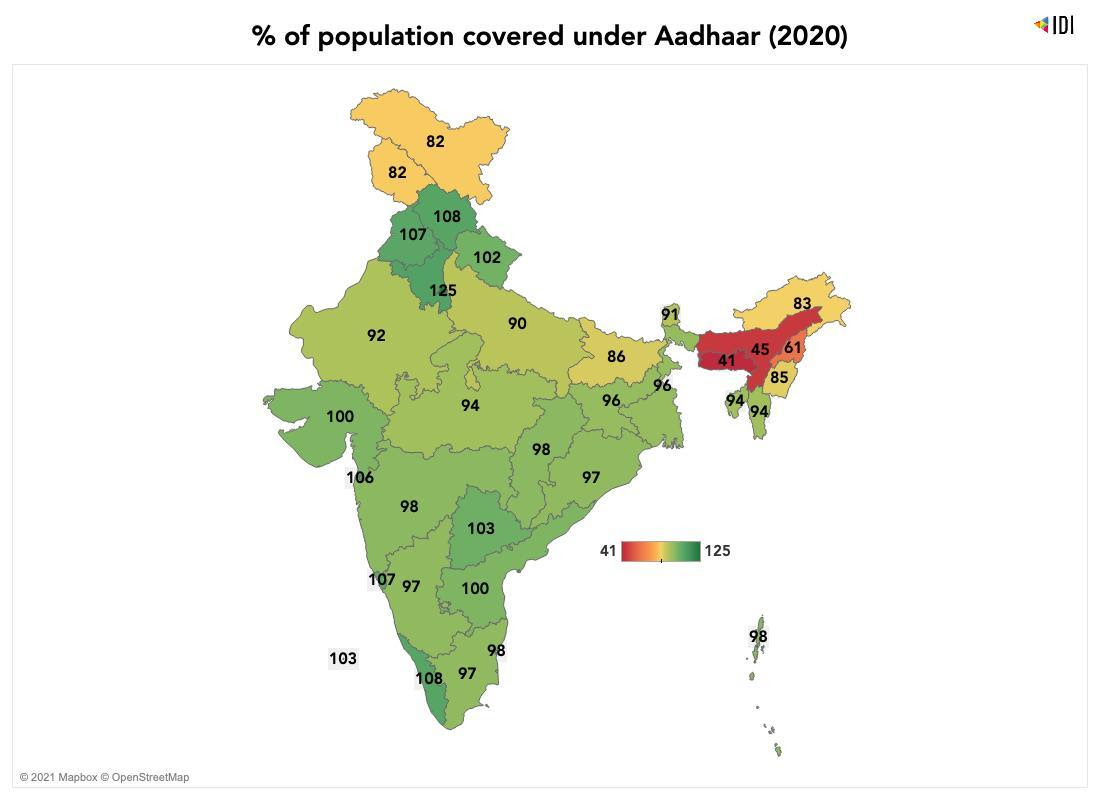 Corporate Contributions
SDG 16 aims to promote peaceful and inclusive societies for sustainable development, it also aims to provide access to justice for all and build effective, accountable and inclusive institutions at all levels.
Some of the sectors (though indirect) which receive funds from corporates to address these areas include
Corporate Contributions
SDG 16 aims to promote peaceful and inclusive societies for sustainable development, it also aims to provide access to justice for all and build effective, accountable and inclusive institutions at all levels.
Some of the sectors (though indirect) which receive funds from corporates to address these areas include
- Armed forces, Veterans, War Widows/Dependents
- Arts & Culture
- Training to promote sports
- Setting-up homes and hostels for women
- Setting-up Orphanages
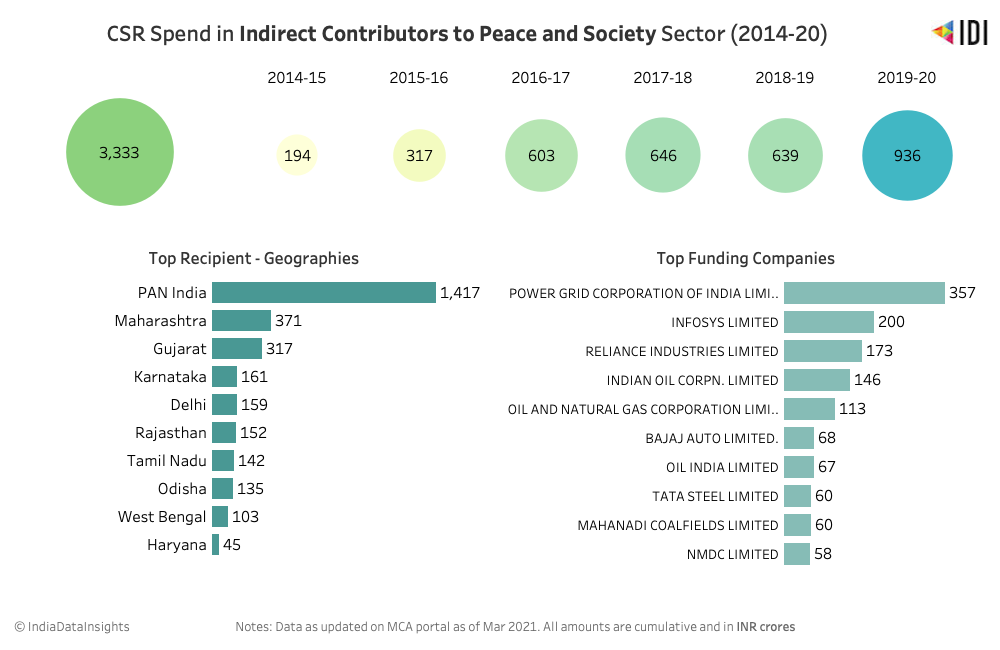 About 3,333 INR crores have been spent on projects related to the above sectors. Six of the top 10 donor companies are PSUs. Powergrid Corporation contributes nearly 10 per cent of the total CSR investment in these areas. Other major contributors include Infosys, Reliance Industries, Indian Oil, and ONGC. Maharashtra, Gujarat, and Karnataka are the top 3 states that received CSR funds for these sectors.
India has a long way to go to create peace and strong institutions while ensuring justice in the nation. However, this milestone would require a concerted effort from all the government bodies involved to drastically improve children’s well-being, human trafficking, and justice.
About 3,333 INR crores have been spent on projects related to the above sectors. Six of the top 10 donor companies are PSUs. Powergrid Corporation contributes nearly 10 per cent of the total CSR investment in these areas. Other major contributors include Infosys, Reliance Industries, Indian Oil, and ONGC. Maharashtra, Gujarat, and Karnataka are the top 3 states that received CSR funds for these sectors.
India has a long way to go to create peace and strong institutions while ensuring justice in the nation. However, this milestone would require a concerted effort from all the government bodies involved to drastically improve children’s well-being, human trafficking, and justice.
